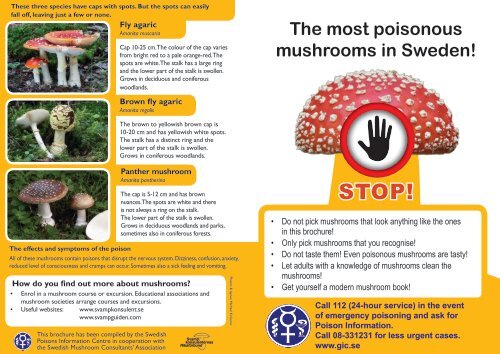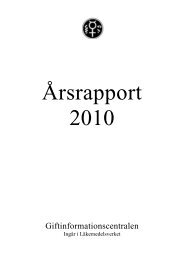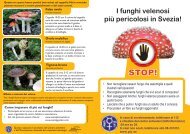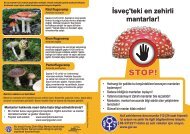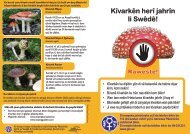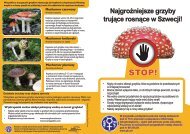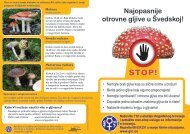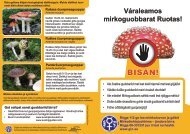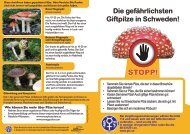The most poisonous mushrooms in Sweden!
The most poisonous mushrooms in Sweden!
The most poisonous mushrooms in Sweden!
You also want an ePaper? Increase the reach of your titles
YUMPU automatically turns print PDFs into web optimized ePapers that Google loves.
<strong>The</strong>se three species have caps with spots. But the spots can easily<br />
fall off, leav<strong>in</strong>g just a few or none.<br />
Fly agaric<br />
Amanita muscaria<br />
Cap 10-25 cm. <strong>The</strong> colour of the cap varies<br />
from bright red to a pale orange-red. <strong>The</strong><br />
spots are white. <strong>The</strong> stalk has a large r<strong>in</strong>g<br />
and the lower part of the stalk is swollen.<br />
Grows <strong>in</strong> deciduous and coniferous<br />
woodlands.<br />
Brown fly agaric<br />
Amanita regalis<br />
<strong>The</strong> <strong>most</strong> <strong>poisonous</strong><br />
<strong>mushrooms</strong> <strong>in</strong> <strong>Sweden</strong>!<br />
<strong>The</strong> brown to yellowish brown cap is<br />
10-20 cm and has yellowish white spots.<br />
<strong>The</strong> stalk has a dist<strong>in</strong>ct r<strong>in</strong>g and the<br />
lower part of the stalk is swollen.<br />
Grows <strong>in</strong> coniferous woodlands.<br />
<strong>The</strong> effects and symptoms of the poison<br />
Panther mushroom<br />
Amanita panther<strong>in</strong>a<br />
<strong>The</strong> cap is 5-12 cm and has brown<br />
nuances. <strong>The</strong> spots are white and there<br />
is not always a r<strong>in</strong>g on the stalk.<br />
<strong>The</strong> lower part of the stalk is swollen.<br />
Grows <strong>in</strong> deciduous woodlands and parks,<br />
sometimes also <strong>in</strong> coniferous forests.<br />
All of these <strong>mushrooms</strong> conta<strong>in</strong> poisons that disrupt the nervous system. Dizz<strong>in</strong>ess, confusion, anxiety,<br />
reduced level of consciousness and cramps can occur. Sometimes also a sick feel<strong>in</strong>g and vomit<strong>in</strong>g.<br />
How do you f<strong>in</strong>d out more about <strong>mushrooms</strong>?<br />
• Enrol <strong>in</strong> a mushroom course or excursion. Educational associations and<br />
mushroom societies arrange courses and excursions.<br />
• Useful websites: www.svampkonsulent.se<br />
www.svampguiden.com<br />
This brochure has been compiled by the Swedish<br />
Poisons Information Centre <strong>in</strong> cooperation with<br />
the Swedish Mushroom Consultants' Association<br />
Photos & layout: Michael Krikorev<br />
STOP!<br />
• Do not pick <strong>mushrooms</strong> that look anyth<strong>in</strong>g like the ones<br />
<strong>in</strong> this brochure!<br />
• Only pick <strong>mushrooms</strong> that you recognise!<br />
• Do not taste them! Even <strong>poisonous</strong> <strong>mushrooms</strong> are tasty!<br />
• Let adults with a knowledge of <strong>mushrooms</strong> clean the<br />
<strong>mushrooms</strong>!<br />
• Get yourself a modern mushroom book!<br />
Call 112 (24-hour service) <strong>in</strong> the event<br />
of emergency poison<strong>in</strong>g and ask for<br />
Poison Information.<br />
Call 08-331231 for less urgent cases.<br />
www.gic.se
Destroy<strong>in</strong>g angel<br />
Amanita virosa<br />
Deadly webcap<br />
Cort<strong>in</strong>arius rubellus (C. speciosissimus)<br />
<strong>The</strong> entire mushroom is white.<br />
Cap 5-12 cm. <strong>The</strong> stalk usually<br />
has a r<strong>in</strong>g, but sometimes not.<br />
When really young they look<br />
like eggs. <strong>The</strong> lower part of the<br />
stalk, which usually sits deep <strong>in</strong><br />
the moss, is swollen. Destroy<strong>in</strong>g<br />
angel grows <strong>in</strong> mossy p<strong>in</strong>e forests<br />
and beech woods.<br />
<strong>The</strong> effects and symptoms of<br />
the poison<br />
<strong>The</strong> poison damages the liver. Symptoms<br />
<strong>in</strong>clude watery diarrhoea, sick feel<strong>in</strong>g<br />
and vomit<strong>in</strong>g that beg<strong>in</strong>s many hours after<br />
consum<strong>in</strong>g the mushroom. Can cause serious<br />
damage to the liver. Poison<strong>in</strong>g could be fatal.<br />
Death cap<br />
Amanita phalloides<br />
Cap 5-12 cm. <strong>The</strong> cap colour varies a great<br />
deal, from al<strong>most</strong> entirely white to green<br />
or grey and light brown nuances. <strong>The</strong><br />
gills are white. <strong>The</strong> stalk has a th<strong>in</strong><br />
r<strong>in</strong>g, but not always. <strong>The</strong> lower<br />
part of the stalk is swollen.<br />
Death cap grows <strong>in</strong> deciduous<br />
woodlands, mixed forests<br />
(deciduous and coniferous<br />
trees grow<strong>in</strong>g together)<br />
and <strong>in</strong> meadows with<br />
beech, oak and hazel.<br />
<strong>The</strong> effects of the poison<br />
and symptoms<br />
Conta<strong>in</strong>s the same poison as<br />
the destroy<strong>in</strong>g angel. <strong>The</strong> same<br />
symptoms and just as deadly –<br />
see above!<br />
Cap 4-8 cm. <strong>The</strong> whole mushroom is<br />
reddish brown to yellowy brown. <strong>The</strong><br />
cap is usually conical, but not always.<br />
Grows <strong>in</strong> mossy p<strong>in</strong>e forests and beech<br />
woods. Fool's webcap (C. orellanus) is<br />
a similar species that conta<strong>in</strong>s the same<br />
poison. It grows <strong>in</strong> deciduous woodlands<br />
with oak, beech and hazel.<br />
<strong>The</strong> effects and symptoms of the poison<br />
<strong>The</strong> poison damages the kidneys and could<br />
completely destroy them. Signs of poison<strong>in</strong>g<br />
do not occur until several days after consum<strong>in</strong>g<br />
the mushroom. Symptoms <strong>in</strong>clude thirst, ach<strong>in</strong>g<br />
muscles, <strong>in</strong>creased or reduced amounts of ur<strong>in</strong>e.<br />
Poison<strong>in</strong>g could lead to long-term dialysis treatment and<br />
<strong>in</strong> some cases even a kidney transplant.<br />
False morel<br />
Gyromitra esculenta<br />
False morel belongs to a completely different<br />
group of <strong>mushrooms</strong>. <strong>The</strong> cap is 4-12 cm,<br />
brown and bra<strong>in</strong>-shaped. <strong>The</strong> stalk varies<br />
<strong>in</strong> colour with light grey, brown or<br />
pale violet nuances. False morel<br />
grows <strong>in</strong> spr<strong>in</strong>g from April until<br />
the birch has leafed, usually along<br />
woodland roads, near uprooted<br />
stumps or <strong>in</strong> felled clear<strong>in</strong>gs.<br />
<strong>The</strong> effects of the poison<br />
and symptoms<br />
<strong>The</strong> poison disrupts the<br />
nervous system and could<br />
also damage the blood cells<br />
and liver. Symptoms <strong>in</strong>clude<br />
dizz<strong>in</strong>ess, double vision<br />
and slurred speech. A sickly<br />
feel<strong>in</strong>g and stomach ache are<br />
also possible symptoms.


